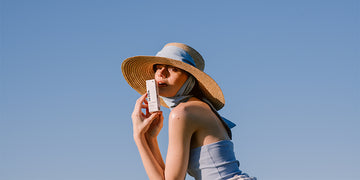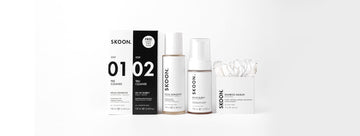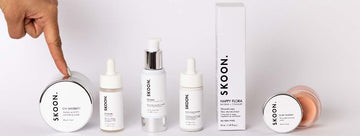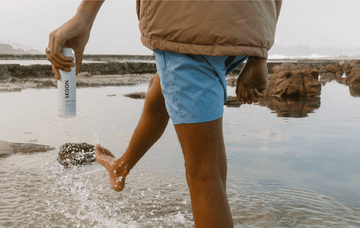I have a hyperpigmented age-spot smack bang in the middle of my left cheek. My morning beauty ritual is to cover my mark with foundation. First step, without fail.
It is interesting to read that Vogue says it is time to say good-bye to flawless skin. I couldn’t agree more (saying this while covering said flaw)😊
The reality is that uneven skin tone is a real concern that has a big impact on skin confidence.
In this blog I unpack the different types of hyperpigmentation. I will touch on the various causes and symptoms associated with hyperpigmentation and wrap it all up by discussing key ingredients and solutions that can help treat your hyperpigmentation.
So without further ado…
Table of contents
- What is hyperpigmentation?
- What are types of hyperpigmentation & their associated skin symptoms
- The causes & triggers of hyperpigmentation explained
- What is the best way to treat hyperpigmentation?
- How to be pro-active with hyperpigmentation
What is hyperpigmentation?
To understand hyperpigmentation, you first need to understand the role of melanin in your skin.
What is Melanin?
Melanin is the pigment that is responsible for our beautiful variety of skin tones and shades. Some of us associate melanin with a golden tan. Others may despair over this skin pigment. Especially if it causes marks and splotches all over our skin.
So how does melanin work?
Our body has special cells called melanocytes to produce melanin. Melanocytes need the amino acid, Tyrosine, to function effectively. Keep this in mind for later when we discuss solutions on how to treat hyperpigmentation.
A less known fact about melanin is its important biological function.
Melanin helps protect the cells of our outer skin against damage from UV light. It does so by absorbing UV light before it’s able to damage the sensitive DNA of the skin cells. Melanin protects against all forms of UV light, UVB + UVA as well as blue light. Think of melanin as the skin's highly effective first line of defense against damaging sun rays.
Take away fact: we want melanin because it protects our skin.

Hyperpigmentation - when things go wrong.
Melanin should be produced in an even fashion. Sun damage, hormones, genes, acne, inflammation, to name a few, can all trigger uneven melanin production. When this happens we get uneven areas of darker coloured skin on our face, neck and chest.
These uneven marks and splotches are called hyperpigmentation.
What are types of hyperpigmentation & their associated skin symptoms
Now that we have a fair idea as to what hyperpigmentation is, let us have a look at the various types:
- Solar Mottling (sun freckles, liver spots and dark marks)
- Melasma (Hormonal - pregnancy mask)
- Post Inflammatory Hyperpigmentation (dark spots after acne or picking of skin)
- Periorbital Hyperpigmentation (dark marks around your eyes)
Solar Mottling
Solar mottling is uneven skin tone caused by years of cumulative sun damage. The skin looks mottled and almost leather coloured. Sun freckles, age spots or “liver spots” are part of this type of hyperpigmentation. The common denominator for solar mottling is repeated exposure to sunlight without protection. Make sure you protect your skin with a daily lightweight sunscreen.
SUNNYBONANI SPF40+ Daily defence mineral sun cream is a waterless, lightweight, mineral sun cream offering broad spectrum protection against UVA(geing) and UVB(urning).

Melasma
The second most frequent reason for hyperpigmentation is an imbalance of hormones. This type of hyperpigmentation is called melasma.
Pregnancy mask is another term used for melasma. “Pregnancy mask” refers to the dark butterfly pattern that affects the forehead, cheeks, chin and upper lip during pregnancy.
All melasma is linked to hormones triggering melanocytes to produce more pigment.

Post Inflammatory Hyperpigmentation (PIH)
Post Inflammatory Hyperpigmentation (PIH) occurs after pimples, scrapes or minor skin injuries. Inflammation (the redness) triggers melanin production as an immune response to protect the damaged skin. The dark, hyperpigmented marks are often visible long after the acne or injury has healed.
The name says it all – inflammation is the driver behind this type of hyperpigmentation.
Periorbital Hyperpigmentation
Hyperpigmentation around the eye area can affect skin under the eyes as well as the upper eyelids. This ‘panda effect’ can include hyperpigmentation (dark circles), swelling, fine lines and puffiness around eyes.
Predisposed genetics, stress, raised cortisol levels, lack of sleep and leaky capillaries can all lead to increased deposition of melanin around the ocular area.

The causes & triggers of hyperpigmentation explained
I think it is really important to spend some time on hyperpigmentation triggers since the best treatment option for hyperpigmentation is to first address the source.
Let’s kick off with the No 1 trigger for hyperpigmentation on the list.
You guessed it. The sun and UV rays.
The sun & ultraviolet radiation and hyperpigmentation
UVA is the most prevalent form of UV radiation on earth. UVA presents with equal intensity during all daylight hours. UVA penetrates deeper into the dermis for DNA damage. It penetrates clouds, fog and glass. UVA is the chief tanning ray (also used for tanning in sunbeds).
UVB rays are the chief culprit behind skin reddening and sunburn. UVB rays cannot penetrate through glass and vary in intensity. UVB only penetrates the epidermis and is the root cause of erythema and "burning" or pigmentation - which damages the skin’s outermost layers.
The overproduction of melanin in sun-damaged skin is related to your melanocytes being stuck in “overdrive” – desperately trying to protect skin from UV radiation.
UV rays are the root cause for solar mottling but also worsens all the other types of hyperpigmentation.

Skin colour and hyperpigmentation
We know that our skin’s own built-in defense against the No 1 trigger, UV rays, is our skin pigment called melanin.
What I didn’t mention before is that your skin has two types of melanin called eumelanin and pheomelanin. (There is a third one called neuromelanin. It has to do with your brain so we are not going to chat about it in this blog.)
Eumelanin and pheomelanin are a little bit like two cousins. They look the same but are actually quite different.
Eumelanin is the good cousin. It is UV absorbent and photo-protective.
The second cousin, pheomelanin is photo-unstable and phototoxic.
The Fitzpatrick scale:

The Fitzpatrick scale is used to identify human skin color and it measures the amount of melanin in the skin after sun exposure.
Darker skin on Fitzpatrick 4-6 has a higher content of total melanin. Including, more of the protective, eumelanin.
If you have a lighter skin tone (1-3) on Fitzpatrick Scale you will have more pheomelanin. A higher pheomelanin content makes your skin less photoprotective and more predisposed to hyperpigmentation (and skin cancer for that matter).
Hormones and hyperpigmentation
Estrogen plays a significant role in human skin - this is one of many "youth hormones". It is not called a "youth hormone" for nothing. Estrogen influences skin conditioning and pigmentation.
Estrogen upcycles the expression of tyrosinase. Tyrosine is an amino acid and tyrosinase the enzyme responsible for producing melanin from tyrosine (remember, tyrosinase is a copper containing enzyme needed for melanin production).
Imbalances or increases in estrogen and progesterone - found during pregnancy, the use of birth control pills and hormone replacement therapy - can increase or decrease normal tyrosinase production, contributing to uneven melanin production.
Acne and hyperpigmentation
To better understand why acne causes your Post Inflammatory Hyperpigmentation (PIH) let's have a closer look at the source.
Let’s kick off with a quick explanation on how pimples are formed (remember, it is all about the source).
All skin follicles contain an acne bacteria called Propionibacterium acnes (P. acnes). P. acnes forms part of your normal skin flora and is found at the bottom of your follicles. Like any bacteria, P. acnes constantly divides (making new bacteria) but is also constantly killed off by oxygen. (Yeah for oxygen!).
The problem starts when your follicles become blocked or “clogged”. Clogging is where a build-up of dead skin cells and sticky, solidified sebum blocks the follicle opening. Clogged follicles prevent oxygen from reaching to the bottom creating an ideal environment for P. acnes to multiply unchecked!
Once P.acnes is out of control, the follicle very quickly becomes inflamed with dead cells, sebum, and bacteria. This forms a pimple.
In an attempt to fight the irritation, the skin's inflammatory response rushes white blood cells (killer cells) causing it to fill up with pus (these are your white pimples or pustules). If the inflammation continues, the follicle wall ruptures and the inflammation spreads under the skin surface creating a firm, red nodule which is larger than a pimple.
Another part of the immune response is the triggering of melanin production.
Once the follicle is "rescued" the inflammation will start to heal but the "extra" melanin that has been deposited will remain as dark marks on your skin. The dark marks (lesions) range from light brown to black in colour. The marks will become darker if exposed to sunlight (UV rays).
This is the story of how acne or pimples trigger (post inflammatory) hyperpigmentation.

Your genes and hyperpigmentation
Another major player. Hyperpigmentation has a strong genetic connection.
The production of the two different types of melanin, eumelanin and pheomelanin is down to genetics. Certain genes are linked to a higher pheomelanin production. As mentioned before, pheomelanin is not photo-protective. Higher pheomelanin means you are genetically predisposed to solar mottling including freckling, sunspots, liver spots and uneven tone.
Inflammation, another hyperpigmentation trigger, has equally strong genetic links. A genetic predisposition for inflammation, will in turn increase your tendency for PIH.
Other possible causes of hyperpigmentation
Certain types of diseases and side effects from some medications can also contribute to hyperpigmented skin.
What is the best way to treat hyperpigmentation?
The best way to treat hyperpigmentation is based on my favourite skin mantra… PREVENT & PROTECT. REPAIR. BE PRO-ACTIVE
How to prevent hyperpigmentation?
As in all things prevention is better than cure. Here are some practical tips to minimise potential sun (over)exposure:
- Limit time spent in the sun between 10 am and 4 pm.
- Seek shade wherever possible.
- Wear a wide-brimmed hat.
- Wear tightly-woven, preferably unbleached cotton clothing.
- Clothes made from polyester crepe, bleached cotton and viscose offer little protection because they are transparent to UV rays.
- Avoid sun beds and lamps.
- Wear UV-protective sunglasses.
Remember some exposure to sunlight is necessary (vital actually!) for good health. Sunshine = Vitamin D 😊

Protect your skin from sun exposure with sunscreens
As mentioned before sun exposure is the No 1 trigger for hyperpigmentation. It goes without saying that wearing sunscreen is a good place to start then. So let us pause for a bit and put sunscreens under the microscope.
There is a lot of confusion around sun care at the moment. The hot debate: chemical sunscreens vs mineral sunscreens.
Let’s have a look at the main difference between these two types of sunscreen.

Chemical Sunscreens
Chemical sunscreens contain chemical filters (also sometimes referred to as organic filters although it is not associated with being organically certified) that absorb UV rays and redistribute the energy as heat.
Here’s what I don’t love about absorbing sunscreens. The energy released may not be a problem for most but if you have sensitive skin or redness (e.g. rosacea or menopause) the heat may exacerbate your skin issues.
In addition, the FDA (USA) has recently found that six of the chemical filters used routinely in sunscreens — avobenzone, oxybenzone, octocrylene, homosalate, octisalate, and octinoxate — are not only absorbed directly into the bloodstream, but they do so at “toxic” levels.
Food for thought.
Mineral Sunscreens
Mineral sunscreens on the other hand work by coating your skin with a layer of minerals that physically reflect the rays away from your skin.
It goes without saying that I love mineral sunscreens. Fragrance free, mineral sunscreens are well suited to all skin types including sensitive . The mineral, zinc, is one of my all-time favourite skin ingredients. Besides being a superb reflective sunscreen active it is also great at healing skin.
For darker skin (Fitzpatrick 4-6) mineral sunscreens may have the downside of giving a white cast, or even blue-ish appearance. The good news is that colour tints enhance the SPF of mineral sunscreens. Look out for tinted mineral sunscreens that compliment your skin tone.
Finally, make sure your sunscreen clearly states “broadspectrum UVA + UVB”. Unless it contains this statement you can assume it is only protective against UVB rays. Not good! Why? The “A” in UVA stands for UVA(geing). Your sunscreen should do a proper job by reflecting both types of rays and not only UVB.
Not only does our SKOON. SUNNYBONANI Day Defense Sun Cream (SPF 20) provide protection against both UVA and UVB but the formula is also lightweight and 100% mineral based.

SUNNYBONANI Day Defense Sun Cream SPF 20
Sanibonani, SUNNYBONANI Day defense sun cream SPF20! Meet your new sun guardian. Natural, mineral-only-based sunscreen for your face. Inspired by the sun-baked African continent. Lightweight - absolutely no sticky feel. Rich in natural minerals. Oh-so-perfect to add as the last step of your morning skincare routine.
- Broad-spectrum UVA(geing) + UVB(urning)
- Zero, nada, no chemical filters!
- Only non-nano minerals
- No clogging & perfect for daywear over moisturisers and serums
View Product
How to repair hyperpigmentation
Step 1 - Exfoliate
The first step to repair hyperpigmented skin is to exfoliate dead surface cells that are already stained with melanin. Exfoliation can be done with a variety of methods and ingredients but the aim remains the same – slowly peeling off the stained cells to reveal cells underneath that are non-stained and even in colour.
Keep in mind this is not an overnight process. It may take months to get back to a normalized colour.
Are you impatient and thinking of aggressive peels to expedite the process? Not a good idea.
Too many or too strong peeling treatments can worsen hyperpigmentation due to post-treatment inflammation.
Moral of the story, pigmentation is a turtle race. Don’t overdo treatments or try to hurry the process. Take your time to invest in a phenomenal exfoliant that gives sustainable results.
TIP: Try to incorporate additional daily exfoliation by using any of the SKOON. moisturisers - all of them contain the mild and gentle exfoliant, salicylic acid. Another option (especially if you are struggling with PIH) is our SKOON. OH SHERBERT Exfoliating Face Mask. A gentle, powder-to-paste, exfoliating clay mask that provides exfoliation and multitasks as a treatment for breakouts.

OH SHERBET! Exfoliating Face Mask
Use OH SHERBET! Azelaic acid 10% exfoliating clay mask daily for breakouts. Gentle Cape clay is super absorbent and will further help to mop up excess oil and dry out bumps and blemishes. Although OH SHERBET! is a wash-off mask you can also spot treat individual breakouts with dabs of clay mask and leave it on overnight.
- Gentle exfoliation - no harsh abrasions
- Mops up excess oil
- Reduces breakouts
- Anti-redness
View Product
Step 2 – Suppress Melanin

The second step to repair hyperpigmentation is to incorporate products that contain melanin suppressants. Melanin suppressants are topical ingredients that interfere with the process that produces melanin in skin cells. Think of it like this. You are stopping the staining at the source.
Vitamin C, phytic acid and kojic acid are examples of ingredients that have melanin suppressing action. The SKOON. WOW-WOW WONDER 3-Hyaluron Face Serum contains Vitamin C in the form of Sodium Ascorbyl Phosphate (SAP). SAP is an effective tyrosinase inhibitor. Remember we touched on tyrosinase and its role in melanin production in the previous section: What is Melanin?

WOW-WOW WONDER 3-Hyaluron Face Serum
Dehydration is no match for our WOW-WOW Wonder serum. This 3-in-1 water-based wonder is fortified with a trio of Hyaluronic Acid molecules (high, medium and low), Buchu and Vitamin C for the perfect moisture top-up and a brighter, even skin tone.
- Boosts hydration and suppleness
- Brightens and evens out skin tone
- Exfoliates without irritating
- Helps to fade pigmentation
View Product
How to be pro-active with hyperpigmentation
Pro-active skincare is having a 360° view on all aspects that may contribute to your hyperpigmentation. Genes, sun exposure, underlying hormonal and inflammatory issues all have an influence.
A good place to start is doing a DNASkin at home skin genetics test. This state-of-the-art scientific test reveals your genetic blueprint and any underlying genetic factors that may drive hyperpigmentation.
Find out more on how to be pro-active with hyperpigmentation.

Knowing your genes will allow you to incorporate nutrigenomics in your skincare routine.
Nutrigenomics is the science of influencing the expression of your genes (and by definition your hyperpigmentation) through lifestyle changes, diet and targeted supplements. If you know your genetic skin drivers by doing the DNASkin test you can incorporate nutrigenomics to personalise your skincare routine and help minimise hyperpigmentation.

Final thoughts on hyperpigmentation
Back to my original statement. Maybe it is time to move on from the concept of flawless skin. There is something lifeless about the photoshopped images that we are bombarded with on a daily basis. In reality skin is a very expressive organ full of movement and expression. Time to embrace this vibrancy!
That is not to say we cannot address our skin concerns in a thoughtful and pro-active way. I hope this blog has shed some light on hypermentation and its various causes and potential solutions. Please pop feedback into the comments section below - I would love to hear from you.
PS: SKOON has launched Trial Kits to allow you to try-before-you-buy! For solar mottling try the HYPERPIGMENTATION Kit and for PIH I suggest both the BREAKOUTS Kit & HYPERPIGMENTATION Kit.





